The Intrinsic Reality: Between Seeing and Being
Photography, Susan Sontag reminds us, is never merely about the world in front of the lens—it is also about the mind behind it. Every photograph represents two truths: the photographic reality—what the camera captures—and the reality of the photograph—what the image conveys once it begins to live independently of its maker.
This distinction forms the heart of my project, The Intrinsic Reality, a visual and philosophical exploration of how meaning transcends the mechanical act of taking a picture. Through ten photographs, the project investigates the quiet tension between the factual and the interpretive, the visible and the felt.
Between the Photograph and Its Meaning
A photograph is often mistaken for evidence, a frozen fragment of time. Yet, as Sontag wrote, “Photographs alter and enlarge our notions of what is worth looking at.” To photograph is not to reproduce reality—it is to select, to isolate, and, ultimately, to construct a version of it.
The photographic reality is literal: light, subject, composition. The reality of the photograph, however, is shaped by emotion, memory, and perception—both the photographer’s and the viewer’s. Between these two realities lies what I call the intrinsic reality: a silent, shifting space where the image ceases to be an object and becomes a conversation.
This project is my attempt to illuminate that space. Each photograph invites reflection not merely on what is shown, but on what is felt—the quiet implication behind the visible frame.
The Role of the Written Word
Photography has long been hailed as a universal language. Yet universality can also be ambiguity. Without words, an image risks floating untethered, vulnerable to misreading or indifference. That is why I believe every meaningful photograph deserves a written companion—not an explanation, but an invitation.
The written synopsis in this project functions as a guide, not a map. It offers context, provokes curiosity, and creates an entry point into the image’s deeper dimensions. A viewer may disagree with my interpretation, and that disagreement is welcome. The goal is not consensus but contemplation.
In this way, writing becomes an extension of seeing—a second lens that refracts rather than defines. It allows the viewer to linger, to question, and perhaps to remember.
The Ten Photographs
The ten images presented here trace different facets of contemporary existence—urban isolation, resilience, consumer desire, the passage of time, and the subtle poetry of ordinary gestures. Some depict the human presence within the machinery of modern life; others explore spaces marked by absence or abandonment.
Each image operates at two levels:
Photographic reality — the surface, the documentary fact, the image as seen.
Reality of the photograph — the interpretive truth, the emotional echo that emerges through the act of viewing.
For example, a bustling street scene may at first appear chaotic, yet within it lies a rhythm of survival, a silent choreography of movement and fatigue. A portrait may seem straightforward, yet the gaze it captures hints at an inner monologue the viewer can only imagine.
These are not staged moments but found realities, discovered through wandering, observation, and empathy. Together, they question what it means to look—and what it means to understand.
The Viewer as Co-Creator
In Sontag’s view, every photograph is incomplete until someone looks at it. Meaning is not embedded in the image; it is created in the act of interpretation. The viewer brings their own stories, beliefs, and emotional history to what they see, reshaping it each time.
I have no expectation that my interpretation will align with that of the viewer. In fact, I hope it does not. The real success of photography lies in its ability to generate dialogue, to encourage contradiction. If an image invites reflection—if it stirs disagreement, empathy, or even discomfort—then it has transcended the boundaries of visual pleasure.
A photograph that provokes thought becomes a mirror, reflecting not only the subject but the self of the viewer. The intrinsic reality, then, is not a fixed truth—it is a living negotiation between the image, the photographer, and the observer.
A Philosophy of Ambiguity
Sontag warned that photographs can both reveal and anesthetize—that they can bring us closer to reality while numbing our capacity to feel it. To resist that numbness, this project seeks ambiguity rather than clarity.
Each image is an open question. What is happening here? Who are these people? What emotion lingers beyond their faces or gestures? The camera may not answer, but the photograph insists we ask.
By embracing this uncertainty, I hope to restore to photography its moral and emotional depth—a return to curiosity, to slowness, to meaning. The camera, after all, does not create reality; it frames our relationship to it.
Why Intrinsic Reality Matters
In an age of ceaseless image production, we rarely pause to think about what we see. We scroll through hundreds of photographs daily, yet retain almost none. The visual experience has become frictionless—an aesthetic of consumption rather than contemplation.
The Intrinsic Reality project proposes an alternative: to treat each photograph as an encounter, not an object. To ask not only what it shows, but why it matters.
By pairing each image with a brief text, I hope to slow the process of seeing—to transform viewing into reflection. A written note, even a short one, becomes a prompt for empathy, an anchor for memory.
If, after looking, a viewer leaves not with a fleeting impression but with a lingering thought—whether in agreement or dissent—then the photograph has achieved its purpose. It has entered the heart through the doorway of thought.
Conclusion: The Dialogue of Seeing
Photography, at its core, is a dialogue between presence and absence. What is shown and what is left unseen are equally powerful forces. The intrinsic reality lies somewhere between them—a fragile equilibrium between truth and interpretation.
Through these ten photographs, I am not offering certainties, but questions. I am not defining reality, but inviting others to reconsider it.
Sontag once said, “To collect photographs is to collect the world.” But to truly see them is to collect ourselves—to confront the fragmentary, shifting, and often contradictory nature of our own perception.
If my photographs linger in the mind of a viewer, if they provoke thought or even quiet disagreement, then they have done what I set out to achieve. The image will have transcended its surface to become experience—its intrinsic reality realized through the act of looking.
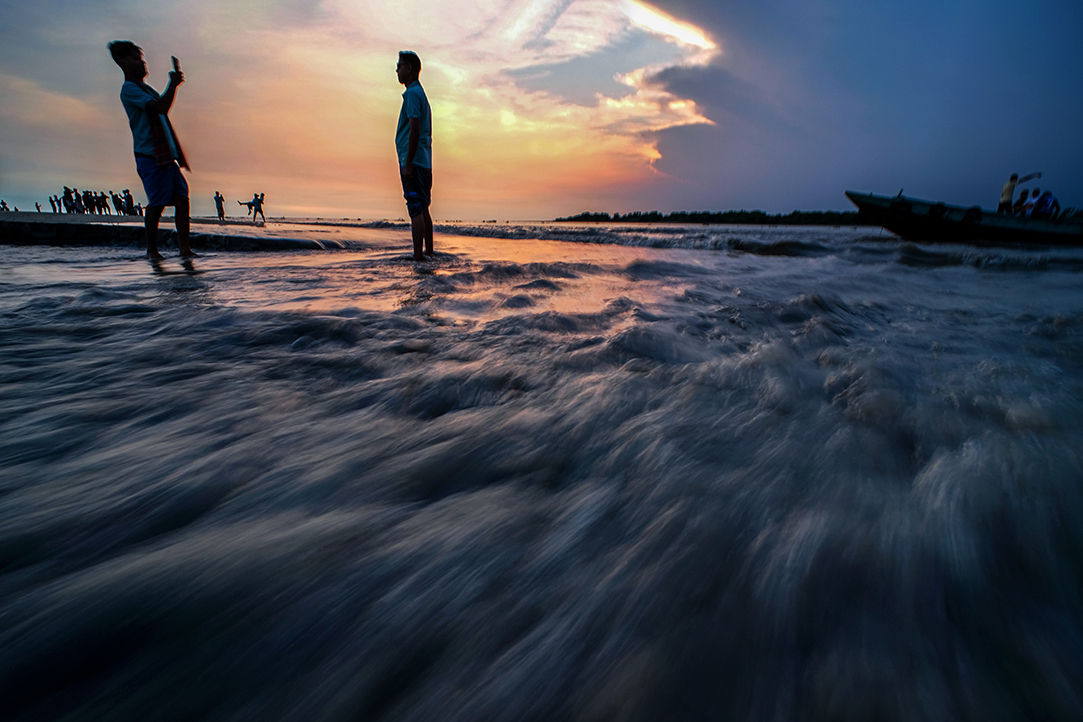
In Search of Baudelaire’s Silence
Baudelaire once said: “Modernity is the transient, the fleeting, the contingent; it is one half of art, the other being the eternal and the immutable.”
Baudelaire and Wordsworth, in their own ways, turned away from the mechanized rhythm of the Industrial Revolution and sought refuge in the quiet grace of nature. Both believed that the human spirit finds its truest reflection not in the noise of progress, but in the stillness of the natural world — to experience it with calmness, poise, and a sense of reverence.
This photograph stands as a gentle reminder of why they looked back. The sun dips into the horizon, painting the sky with molten gold; waves roll and dissolve softly at our feet. In juxtaposition, we hold up a device — to frame, to capture, to share — as though the proof of beauty lies not in our hearts, but in pixels.
In this age of postmodernity, our connection to the world has become fleeting, mediated by screens and signals. The moment is recorded, but seldom remembered. What could have been etched into memory and feeling now lives only in storage — a forgotten file, a passing flicker of light.
Perhaps, like the Romantics, we too must learn again to look, to feel, and to simply be — without the need to document, without the impulse to prove.
Deem Char Sea Beach, Sunderban. Date Taken: 18th of October, 2025
The Circle of Joy
In the heart of Bahadur Shah Park, a child runs — barefoot, breathless, free. With a stick and an old rickshaw tire, he creates a universe of his own. The world may see a symbol of poverty; he feels only motion, rhythm, and wind. The spinning tire becomes his sun, his dream, his world — circling endlessly under a patchwork of light and shadow.
He runs not to escape, but to exist. Each turn of the tire erases hunger, erases tomorrow. In that fleeting orbit of play, there is no scarcity, no despair — only pure, uncosted happiness.
Money is irrelevant here. Time, too, stands still. What remains is the simple truth of childhood — that joy can be handmade, that freedom can come from motion, and that hope sometimes rolls forward on nothing more than a discarded wheel.
For now, he lives only this moment — unaware that life itself will one day resemble that same circle: beautiful, uncertain, and hard to control.
Bahadur Shah Park, Old Dhaka. Date Taken: 7th of October, 2025
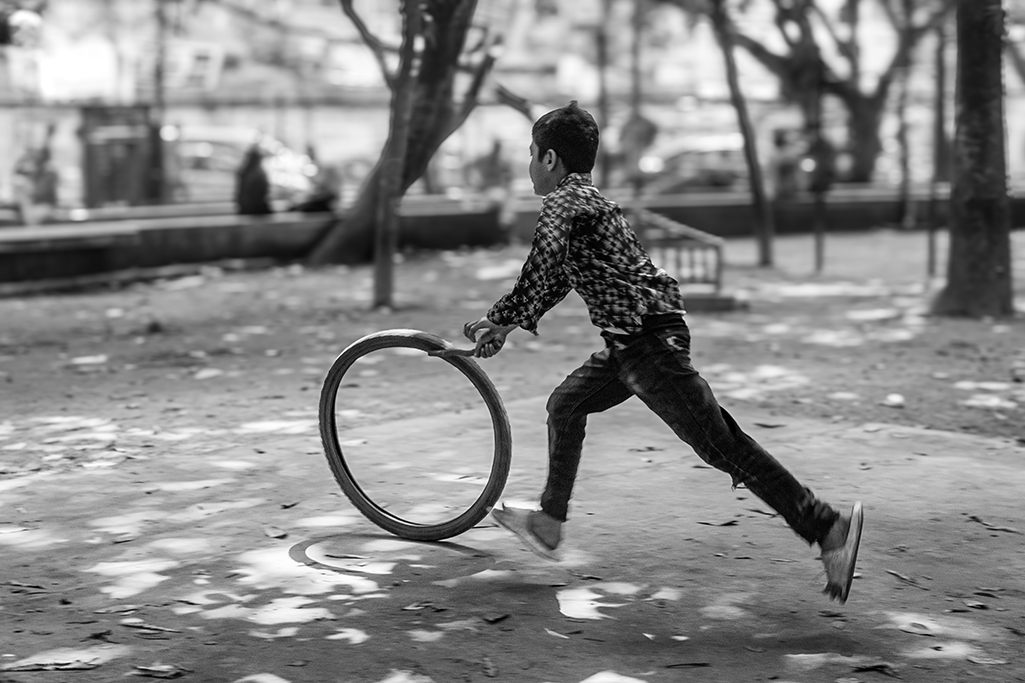
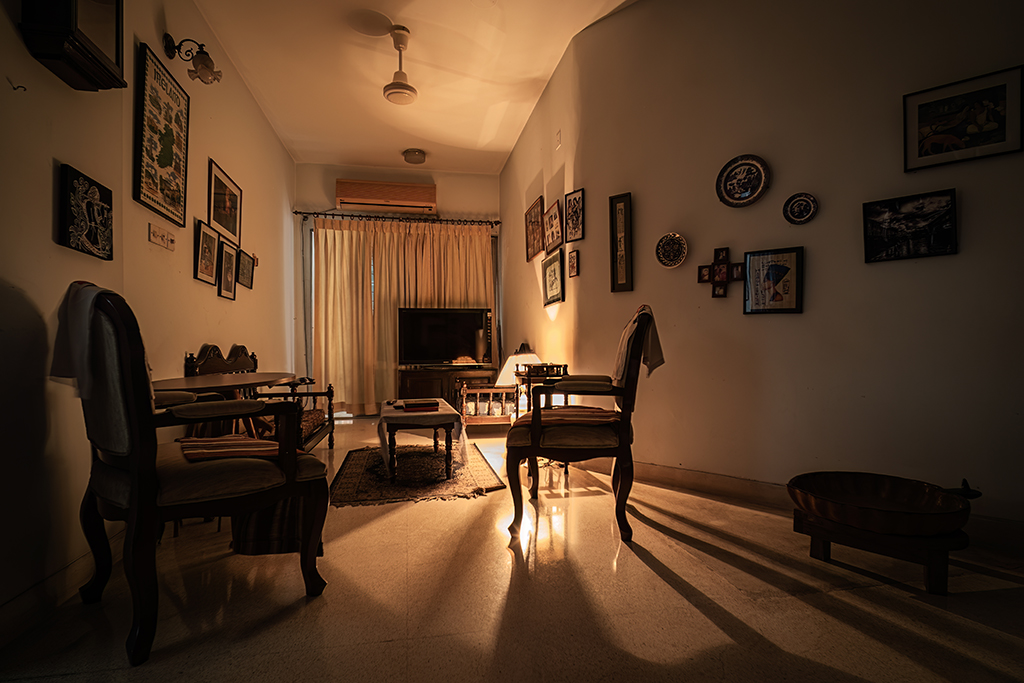
A Dialogue with the Lifeless
Home is where the heart belongs. But what do you call a home when the hearts that once filled it have stopped beating?
This space — 2200 square feet — was once alive with laughter, arguments, conversations, the rustling of my mother’s sari, the familiar sound of my father’s cough. It was more than a house; it was a living, breathing being. Four years ago, my mother left. Two years later, my father followed. Since then, the house has stood silent, like a stage after the final act, curtains drawn but the set still in place.
Every object remains frozen in its position — chairs draped with old clothes, books resting where they were last opened, photographs gazing down with unblinking eyes. They are relics, yes, but more than that, they are witnesses. Their silence is not empty — it hums with absence.
For three years, I have lived among these lifeless things. At first, their stillness suffocated me. Now, strangely, we have grown close. I have made uneasy friendships with the furniture, with the shadows that stretch long across the floor at dusk, with the light that filters through the curtains like hesitant memory. Together, we form an alliance against the loneliness of time.
Every corner is a corridor into memory. They remind me of voices and presences that are no longer here. They are filled with life, yet robbed of soul. Still, we speak to one another — I to them, they to me. We survive together: days folding into nights, nights spilling into days.
Perhaps this is what it means to love what is gone. Perhaps this is what it means to belong. In the end, the heart clings not only to people, but also to spaces — to the walls that once heard our stories, to the objects that hold their silence.
So yes, in its own strange, haunted way, this too is home.
Dhaka, Bangladesh. Date Taken: 28th of September, 2025
Unconditional in a Conditional World
In this photograph, towering over the city is The Shard — a symbol of modern capitalism, ambition, and ruthless corporate culture. These glass giants represent a world built on competition, betrayal, and the relentless pursuit of money and power. In such spaces, trust is a currency easily spent and rarely returned. If given the chance, many in that world would trade loyalty for position, and friendship for profit. The architecture itself becomes a metaphor: sleek, sharp, and cold — a monument to a system that rewards self-interest over sincerity.
In stark contrast or in juxtaposition, walking quietly beneath this skyline is a man and his dog — a humble, grounding presence against the imposing steel and glass. Here, the dog becomes the true hero of the image. While the world above thrives on conditional alliances, the bond between the man and his dog is one of unconditional love. The dog asks for nothing but gives everything — loyalty, companionship, and trust that no corporate ladder or paycheck can buy. He will not leave, even when he is not fed, not pampered, not sheltered. His presence is a quiet defiance of the world behind him — a reminder that authenticity and loyalty still exist, even if they walk on four legs.
This image captures more than a moment — it reveals a truth. In a world where people often betray for profit, the dog stands as a symbol of what we’ve lost, and what we still might hold onto.
London, England. Date Taken: 20th of July, 2025
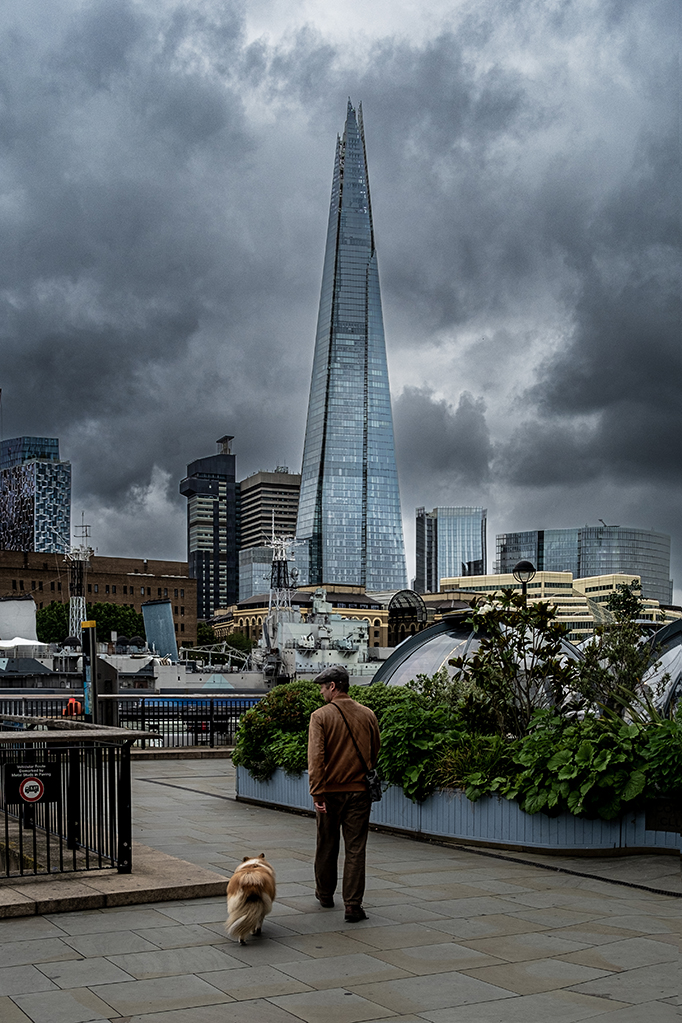
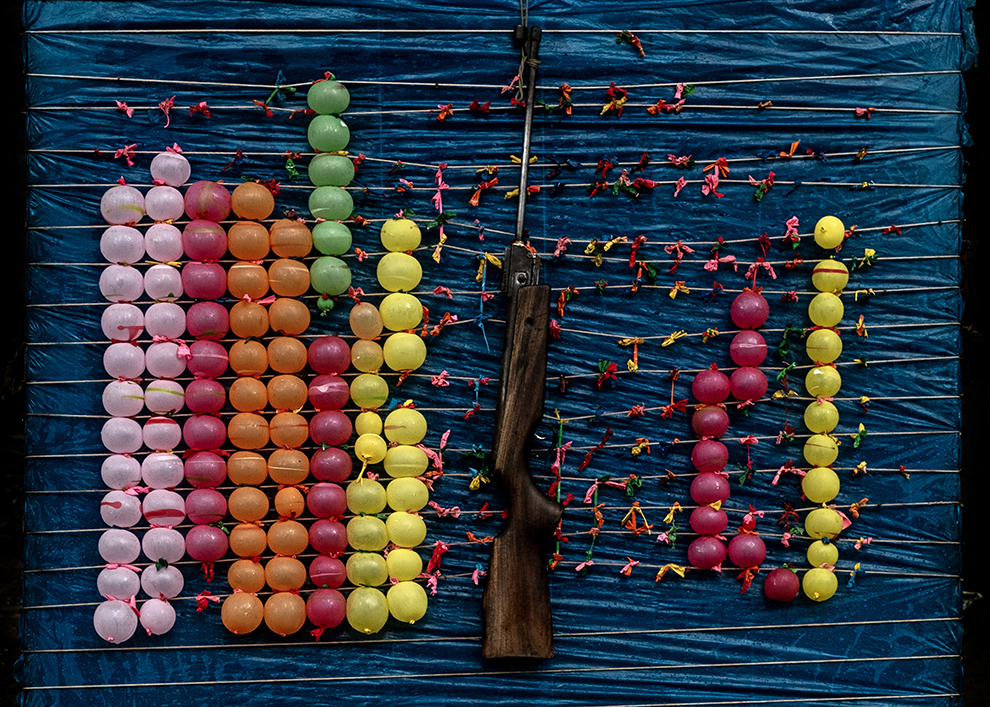
Gun for Fun
A wooden air rifle rests silently against a wall of bursting color — rows of delicate balloons, suspended in stillness, waiting to be popped in play. At first glance, it’s just a carnival game — bright, harmless, and fleeting. But look closer, and it reveals something deeper: a disarmed metaphor in a world that rarely lets its weapons rest.
This image, captured at Dhanmondi Lake, recalls the spirit of John Lennon’s Imagine. It dares to dream of a world where guns no longer take lives but are repurposed for innocent joy, laughter, and shared moments. In this frame, the gun is stripped of fear and violence. It is no longer a tool of destruction, but of pastime, pointing not at hearts, but at harmless targets that vanish with a pop and a smile.
And yet, the remnants of the game — popped balloon fragments tied to arrows — subtly echo the reality outside this frame. The world beyond the lake is not as forgiving. In too many corners of the globe, guns still speak louder than reason, their bullets cutting down lives long before their time.
“Gun for Fun” is both a celebration and a quiet protest. It asks:
Can we not imagine a world where this is the only way a child holds a gun — with joy, not terror?
Where a weapon belongs in a game stall, not a battlefield?
Where every shot ends in laughter, not loss?
It is a reminder for all of us that peace is not passive. It begins with imagination. And sometimes, it begins with something as small as a balloon.
Dhanmondi Lake, Dhaka, Bangladesh. Date Taken: 20th of June, 2023
In the Shade of Civilization
In a quiet border village called Nokshi, nestled within Jhinaigathi, a boy perches effortlessly on the window ledge of his one-room clay house. There are no gadgets in his home. No television humming in the corner, no tablet screen glowing on his lap. And yet, he glows. Not with pixels — but with peace.
He sits in stillness, bathed in natural light, his body relaxed, his eyes alive. The clay wall behind him curves gently like the hills his ancestors once walked freely. The barred window might suggest limitation to some, but to him, it’s a resting place — a perch from which to watch the world he’s a part of, not apart from.
This is not poverty. This is presence. The Garo community, to which this boy belongs, has not been swept up by the speed of postmodernity the way their Bengali counterparts have. But in their slower pace, they’ve held onto something we’ve forgotten: rhythm — with land, with time, with each other. They live not in opposition to nature, but in tune with it. They plant, gather, sing, wait. And in that patient simplicity, happiness blooms.
What strikes the observer is not what is missing, but what is overflowing: contentment, calm, connection. All of it visible in the boy’s posture, in the ease of his smile, in the clarity of his gaze. He is not encumbered by our so-called progress. He is not a step behind — he is a step aside. And in that space, in that shade of civilization, something truer breathes.
As the protagonist of Agantuk, the final film by Satyajit Ray, once asked with poignant clarity:
“If civilization is what we’ve built around ourselves, then tell me — who is truly civilized? The man in the city with five credit cards, or the one who lives with the forest and feels no lack?”
Nokshi, Jhinaigathi. Date Taken: 2nd of July, 2023
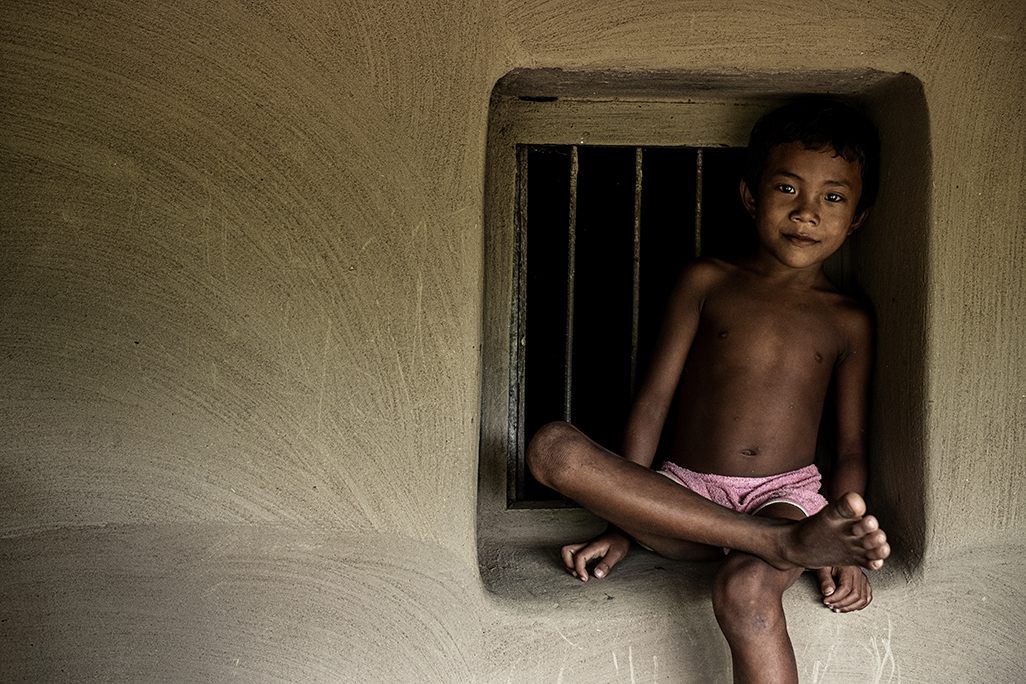
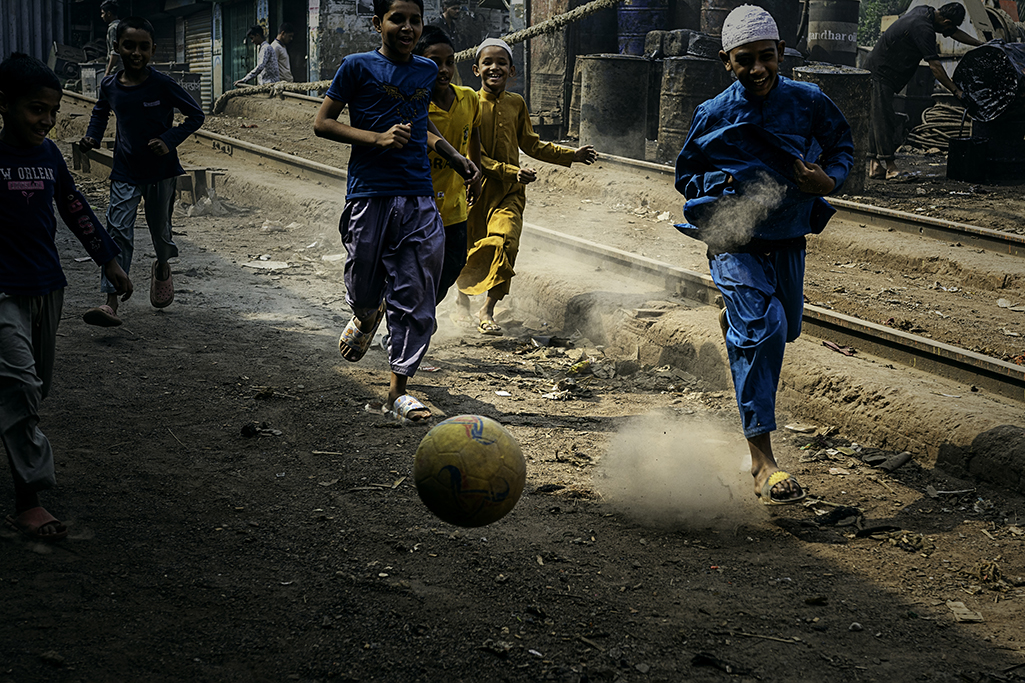
Their Field of Dreams
The ball came flying toward me — a sudden burst of joy rising from a patch of earth that barely qualifies as a playground. I was having lunch, not planning to photograph, but instinct met the moment, and I raised the camera just in time.
The frame cut off at the top. At first, I saw it as a mistake — an imperfection. But later, I realized it was the most honest part of the image. The missing top became a quiet symbol of everything missing from the lives of these children: safe spaces, clean air, proper healthcare, the right to a carefree childhood.
This photo was taken in the dockyard on the banks of the Buriganga, a place thick with dust, metal, and forgotten lives. And yet, in this harsh, unsafe space, the children play — fiercely, freely, beautifully.
They chase a worn-out ball with the same passion as if it were treasure, crafting joy out of ruin. The cropped top mirrors their reality — a childhood where so much has been cut away, yet somehow, the laughter still echoes. What remains is not just a game, but a quiet, defiant celebration of life.
On the banks of River Buriganga, Dhaka, Bangladesh. Date Taken: 5th of January, 2023
Lines Without Questions
A line of madrasa students walks in silent formation — uniformed, and obedient. They follow their teacher through a familiar path, but their eyes do not wander with curiosity; instead, they lower with the weight of routine. There is no resistance. No divergence. Only the fear of what might happen if they step out of line.
“Lines Without Questions” is a visual meditation on systems that demand obedience without understanding — where faith, tradition, and discipline converge to form rituals stripped of wonder. Inspired by the Kafkaesque — particularly works like The Trial and The Castle — this image captures a world where control is embedded not through violence, but through repetition, silence, and expectation.
Like Kafka’s protagonists, these children exist within a structure too vast and abstract to name. The rules are inherited. The authority is distant. The path is drawn long before they are old enough to ask why. And so, they fall in line — not out of belief, but out of fear.
This photograph is not a critique of religion, but of unquestioned systems — of the quiet erasure of inquiry, and the cost of replacing childhood curiosity with compliance. This photo is a reflection on how obedience is shaped, and how early it begins.
Khulna, Bangladesh. Date Taken: 12th of March, 2023
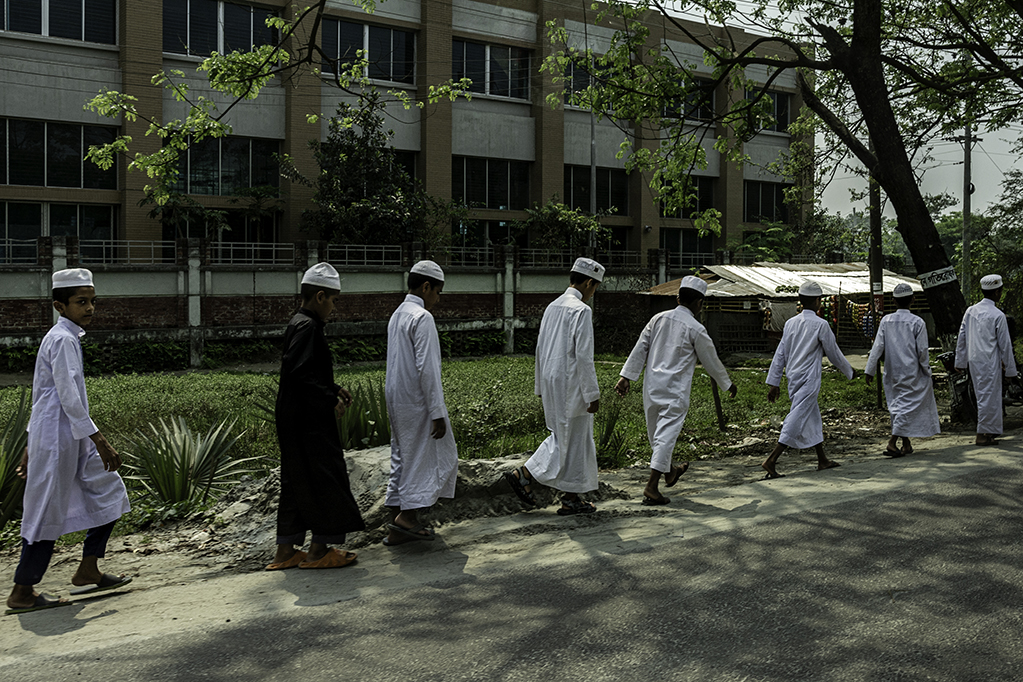
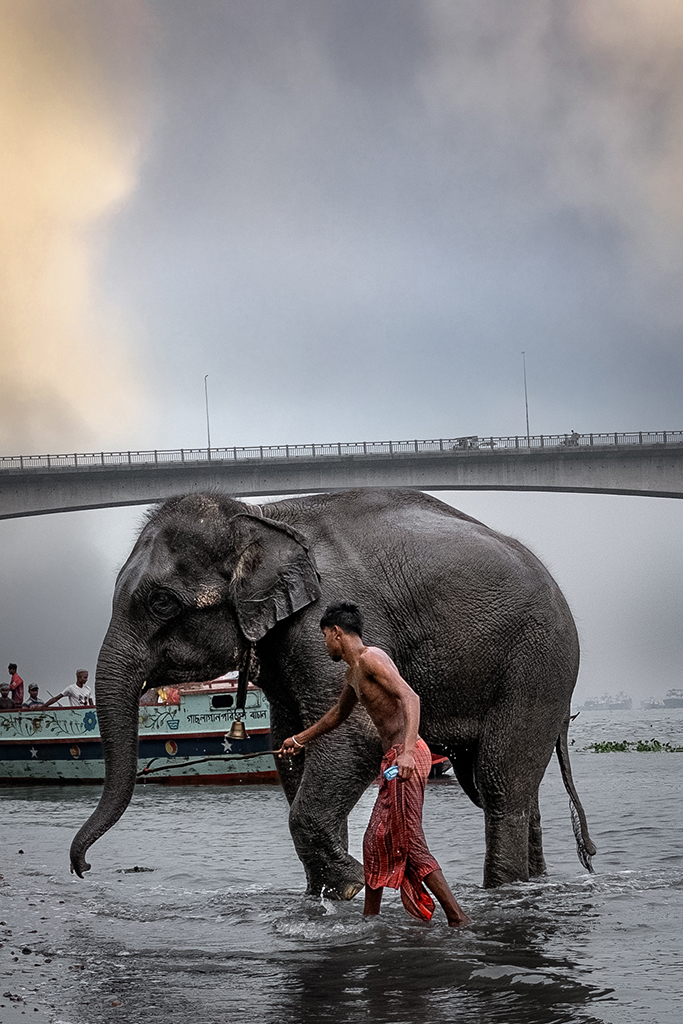
Labour Without Voice: The Hypocrisy We Ignore.
Every year, we honour the dignity of human labour — celebrating those whose hands and strength build our world. Yet, amidst this recognition, we turn a blind eye to the silent labourers who have no voice, no rights, and no wages. This photograph captures a stark reflection of that hypocrisy: an elephant, compelled to toil for endless hours under human command, its immense strength exploited without choice or compensation. While we advocate for fair treatment and justice for workers, we often forget the non-human beings who bear burdens far beyond their will. This image is not just a frame in time — it is a question posed to our conscience. Can we truly celebrate labour while condoning silent exploitation?
Munshiganj, Bangladesh. Date Taken: 20th of March, 2024
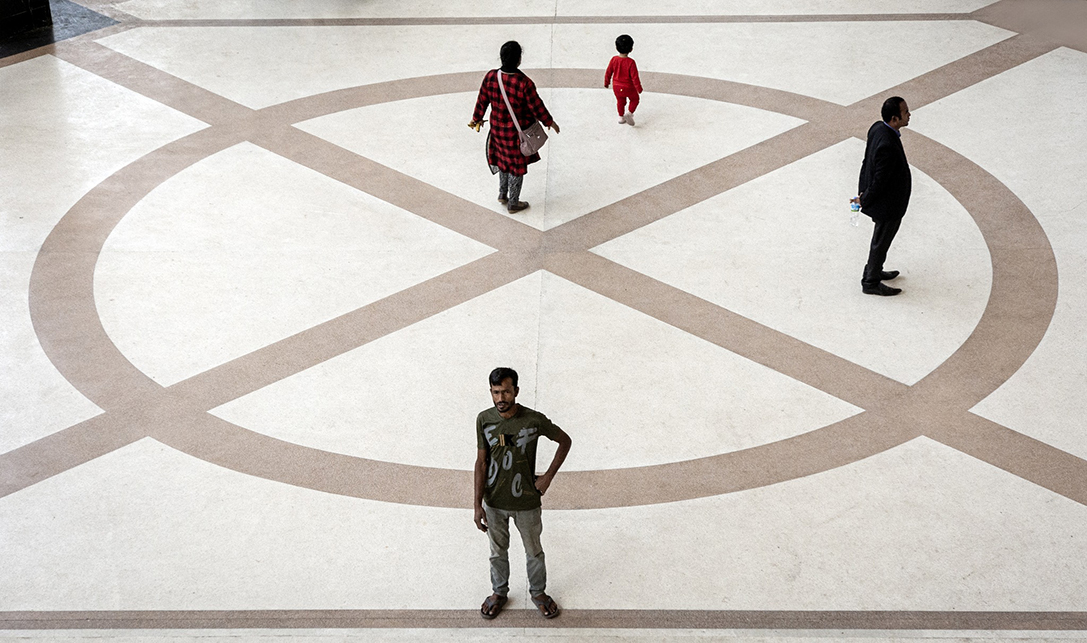
The Geometry of Separation
In this meticulously ordered frame, geometry becomes metaphor. The intersecting lines on the floor, precise and symmetrical, seem to promise connection—yet the people within them remain detached, orbiting their own invisible worlds.
Each figure stands within the same structure, yet their directions diverge—one walking away, another moving forward, one still, another turning inward. The circle binds them spatially but not emotionally. Here, proximity does not translate to intimacy; nearness does not imply togetherness.
The photograph transforms a public space into a map of human distance—a visual paradox where order intensifies isolation. Within these clean lines, life refuses symmetry.
The photographic reality presents four individuals in an architectural pattern.
The reality of the photograph, however, reveals something deeper: the quiet geometry of solitude that defines modern urban existence.
Even in shared spaces, we inhabit our own coordinates—measured not by distance, but by detachment.
Kamalapur Railway Station, Dhaka. Date Taken: 14th of April, 2024












Complimenti, veramente un bel lavoro, e delle considerazioni straordinariamente interessanti
Good one brother!